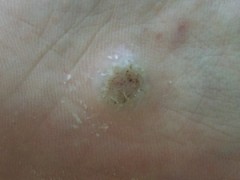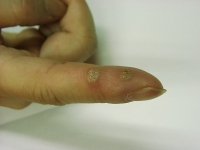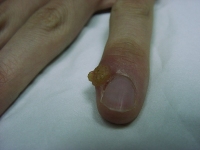Warts are cause by the infection of the superficial skin layer with the Human Papilloma Viruses (HPV), through direct contact of the skin.
Because of our natural immune defense mechanisms, warts may sometimes regress and leave no trace. It may take from a few weeks to a few years. However, immunity to one sub-type of HPV does not offer protection to infection from another sub-type.
Common Warts
They usually happen on the hands and fingers. Each is a discrete, round lump of skin colour. The surface is rough and irregular, and the skin may be thick and hardened. There may be 1 single, or multiple lumps. Sometimes a few of them may join together as a large piece.
|
|
|
If the surface is scrapped with a sharp knife, there appear some bleeding points, which are the blood vessels that grow into the wart.
People who come into contact with raw meat, fish, or shellfish are in particularly high risk of contracting this infection. Very often there may be over 10 of these in one hand.

Planter Warts
They grow in any part of the sole. Because of the pressure from standing, the warts are often pushed inwards. Each is discrete and round, with some hardened white skin in the rim. When many of them coalesce together, it becomes a large piece called mosaic wart.

The blood vessels inside the wart are often clotted (thrombosed) and hardened, and appear as some black dots. This is an important sign that differentiate wart from corn, which is merely a hardened skin because of chronic friction.
Plantar warts can be very painful, due to the hardened skin. It is like having a small stone inside the shoe while walking. Sometimes the pain is due to the thrombosed blood vessels.
Plane Warts
These usually appear on the face or the back of hands, as tiny, flat and slightly raised lumps, with brown or skin colour. With time they will spread slowly, become numerous and more noticeable.
Genital Warts
This is in general regarded as a sexually transmitted disease, through direct sexual contact. Occasionally it may due to the transfer of viruses from a wart elsewhere on the body. They appear as round or flat lumps on the surface, sometimes inside the vagina.
Genital warts caused by some sub-types are highly related to the occurrence of skin cancer on the penis, and cervical cancer.
Management & Treatments
Since there is no medication that can be used to kill the viruses, the usual treatment regime involves direct destruction or removal of the infected tissue. The immune modulators offer a new potential in treatment.
Destruction Methods
1. Wart PaintsThey are simply corrosive liquids, or pastes, that chemically burn the tissue away. This is a blind treatment as the amount of tissue burn is not predictable.
They have a fair chance of success when treating common warts on the hands, because these are usually more superficial. The plantar warts are usually pushed deeper into the skin and the success rate is rather low, and very often they make the skin around the wart soft and soggy, which actually promotes the spread of the wart further.
They should not be applied on the face because of the possibility of scarring.
2. CryotherapyThis involves spraying of very cold liquid nitrogen onto the wart, freezing the skin tissue, so much so that it will eventually drop off. Again this is a blind guess treatment without knowing how deep the freezing temperature has reached. Because of this, it is more effective in treating warts other than plantar warts.
To ensure the freezing go deep enough in the plantar warts, it needs to be applied for a long enough time, and this can be quite painful, which is difficult to achieve without the use of local anaesthetics. This explains the very low success rate when doctors try to treat the plantar warts with cryotherapy, while just asking the patient to withstand the maximal pain they can tolerate.
Overall the success rate is only moderate, with around 60% success after applying 3 - 4 treatments at 2 - 3 weeks intervals.
3. Cauterisation & CO2 LaserThis aims to burn the infected tissue away by using heat. This is achieved by using a cautery or CO2 laser. The wound is left to heal. Usually a bigger margin is burn away too, to remove maximally any tissue still infected with the virus, and minimise the chance of recurrence.
|
|
|
|
Before & Immediately After CO2 Laser |
|
This needs to be done under local anaesthetic. The wound can be examined as the tissue is burn away, and this results in a more accurate guess of whether enough tissue has been removed. For plantar warts, the success rate is high at around 70 – 85%, after one single treatment. For more superficial warts on the hands (except those very close to the nail), face and genital areas, the success rate is close to 100%.
4. Surgical RemovalIf the wart is small, and the area infected can be safely excised, then it can be entirely cut off and the skin sutured. It is 100% effective for small superficial non-plantar warts. It is seldom necessary these days because cauterisation and CO2 laser already offer an effective treatment.
Immune Modulators
1. Imiquimol CreamIt is used mainly for genital warts, although there are evidences that it can be effective in other types too.
It works from within by activating the body's own immune system. When it is applied to the skin, immune cells are activated and travel to the area to eliminate cells that have been infected with the human papilloma virus.
This is applied 3 times per week. The warts should be seen to regress slowly. Overall the success rate is around 60 - 75%.
2. InterferonsThere are quite a few different interferons, alpha, beta, and gamma. They can kill viruses and prevent them from reproducing, as well as stimulate the immune system to fight viruses. It is not the first choice, but may be used when other treatments have failed, or when the numbers of warts are just too many to treat individually. It cannot be used during pregnancy because of harmful effects to the baby.
Previously it is injected into the arm or buttock to achieve an overall systemic effect. Now it can be injected into the base of a wart. The efficacy ranges from 50 - 70%.
Side effects are flu-like symptoms such as fever and chills, muscle aches and pain at the injection site.





